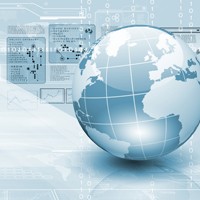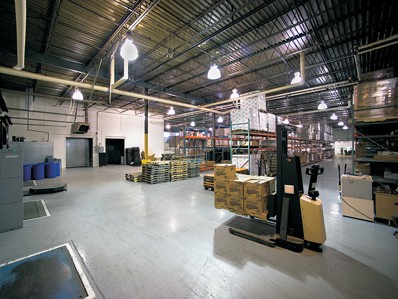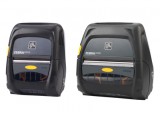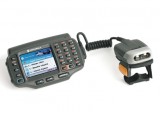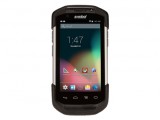Long range Scanning and the Emergence of 2D Bar Codes Introduction Today’s warehouses are rapidly evolving as they seek to keep up with a variety of new requirements and advancements in technology. Processes traditionally using 1-dimensional bar codes are becoming more accurate, more efficient, and more robust through the transition to 2D symbologies. Offering superior data storage capability yet compact in size, these 2D symbols are ideal for cradle-to-grave tracking of products and serialization. As imaging technology progresses, businesses are poised to take advantage of the benefits of implementing 2D while continuing to accommodate the long range scanning requirements typical in the warehouse environment.
Driving this transition is the growing need to track individual parts from assembly to shipment and beyond for information and traceability purposes, largely imposed by company-specific or legislative requirements. A 2D bar code can accommodate significantly more information than its 1D counterpart, and in a fraction of the space, making such traceability possible.
Historically, laser scanners have been the preferred technology in warehousing because of their speed, accuracy, and ability to read at long range. However, as 2D bar codes become more common and imaging technology matures, manufacturers are now discovering what imagers have to offer in terms of flexibility, traceability, and legislative standards compliance.
This paper provides an overview of various bar code symbologies and the decoding technologies available, and explores how bar coding is used in the typical warehouse. Specific scenarios are also highlighted as examples of how emerging 2D use is revolutionizing warehouse operations.
Bar Coding BasicsOver the past few decades, 1D bar coding has streamlined processes throughout many industries. A 1D symbol encodes a series of characters that corresponds to a reference number in a company’s database. Scanning the symbol accesses that specific database record, which stores the information needed for the item being scanned. In other words, the information encoded in the 1D bar code by itself is not useful; rather, the information simply provides a means to access the necessary data. For practical purposes, 1D symbols only encode a few dozen characters – encoding more than this can result in a bar code that is too wide or too dense for a scanner to decode, or for the bar code to be printed on the product.
The 2-dimensional symbol was introduced in the early 1990s and saw more widespread adoption in the 2000s. The data storage capacity of a 2D bar code far exceeds that of its linear (1D) counterpart. Because of this it can encode much of the information formerly kept in the centralized database referenced by the 1D bar code, so applications don’t need to have access to the database. Extremely compact, a 2D symbol can record over 4000 alphanumeric characters and include valuable information such as an item’s serial number, lot information, and time stamp.
2D Symbologies The 2D symbol stacks an array of black and white squares in various patterns, allowing another dimension of data in a small area. This multiplies its informational capacity without increasing its footprint significantly. With inherent error-correction and detection algorithms, these bar codes tend to be extremely robust. Following are a few 2D symbologies frequently seen in warehousing applications.
Data Matrix. This code type can encode over 3000 numeric and 2000 alphanumeric characters, and with its dense storage capacity is ideal for use as location bar codes on very narrow pallet racks. Data Matrix is also increasingly used for direct part marking (DPM) on small components, an extremely durable solution for part serialization.
PDF 417. Developed by Symbol Technologies, PDF 417 (Portable Data File) layers multiple linear codes on top of one another. This symbology is becoming more popular on pallet master labels which use them to encode identification data such as shipping information, pallet number, gross weight, item part number, and add serial number (serialization) quantity.
QR Code. Accommodating 7000 numeric and 4000 alphanumeric characters, QR Code is increasingly employed in the automotive industry as an alternative to 1D for serializing parts that don’t use direct part marking. The packaging for these components is also using QR Code to specify content information such as the tracking number, quantity, and shipping address.
Aztec. This symbology stores up to 3750 ASCII characters, and is constructed on a grid built around a center square bulls-eye. A popular shipping company is currently utilizing Aztec on shipping packages in order to include more data on the enclosed item in a single symbol, increasing employee productivity by reducing the number of scans necessary to obtain this information.
Bar Coding in the WarehouseMany variations of bar codes can be observed within a single warehouse. Small items are often labeled with high density symbols of 7.5 to 20 mil, while boxes or pallets typically use mid-density bar codes. Location markers, which sometimes require reading at typical distances of up to 45 feet, commonly use 70 to 100 mil retro-reflective bar codes.
Following are some frequently used bar code types, which today are chiefly Code 39 or Code 128 symbols:
- Location bar codes. These symbols identify where particular items are stored in the warehouse. They are generally placed on shelves and are often enclosed in protective plastic to prevent wear-and-tear.
- Retro-reflective bar code labels. Larger to accommodate long-range scanning (70 – 100 mil), these labels are typically mounted on a wall or hung from the warehouse ceiling at heights of up to 35 feet. They are primarily used as aisle markers or pallet locators, and are coated with a durable gloss laminate and as such are more expensive than paper labels.
- Floor bar code labels. Found on the warehouse floor, these labels are covered with tape or plastic film, or occasionally made of metal, in order to withstand harsh conditions such as forklift traffic and chemicals.
- Pallet bar code labels. These bar codes are placed on pallets or crates for identification and tracking purposes as they move from one location to another. They are often generated from thermal transfer printers for quality and ease of scanning.
How exactly are bar codes employed in the warehouse? Typical applications are:
- Shipping and receiving. As employees unload incoming boxes from delivery trucks, they scan the bill of lading to verify delivery. This often includes 2D bar codes which are becoming more popular on shipment labels. The ability to take a picture of the incoming merchandise is advantageous in the case of damaged goods or simply to record the condition of the merchandise.
- Pick-and-pack applications. This activity entails breaking a large lot into smaller lots, or “picking” individual boxes or items. The items are then moved to a packing station, or placed on a conveyor belt to transport them to a different location. Near range scanning is required for scanning the individual items to record that they were removed from one location and sent to another.
- Inventory. Forklift operators scan location bar codes as they pick products or put them away to ensure accurate inventory records. This typically requires long range scanning, as location bar codes are often high up on shelves or hung from the warehouse ceiling.
- Outdoor scanning. Some facilities, such as lumber yards, store inventory outdoors. This often involves scanning at both near and long range in bright sunlight.
Warehouse Application Solutions
Application scenario: Long range scanning, limited space for bar codes
Issue: Narrow warehouse racks do not accommodate the space typically required for 1D bar codes, and rack heights vary making scanning from the forklift challenging.
Use case: Picking/forklift application
A food manufacturer placed very small and dense 1D bar codes on narrow vertical racks in their warehouse storage areas for locationing of goods. Because the labels were only decodable at short distances, the forklift operator had to leave the forklift to scan them. The simple solution was to use Data Matrix bar codes, which fit easily on the narrow racks, and an imager that can decode them at up to 10 feet. The forklift operator can now remain on the forklift and efficiently collect all the picking information needed.
Solution: 2D Long Range Imager
Application scenario: Short range 1D and 2D scanning, long range 1D scanning
Issue: Different situations within a single warehouse require scanning 1D location bar codes up close or up to 45 feet away, as well as a wide variety of 1D or 2D product bar code types.
Use case: Picking/serialization
When picking pallets or items from bins, a warehouse employee must scan location bar codes, some of which were placed in bins and scanned up close, and others, like those on pallets, which were up to 45 feet away. Serialization requirements also necessitated scanning the symbol on individual products. As electronics become smaller, 2D use is growing in order to encode all the information necessary in a small area. The solution was to employ imagers with the versatility to decode these 2D symbols while still performing effectively at distances.
Solution: 2D Long Range Imager
Application scenario: ePedigree mandate
Issue: All prescription drugs will require a 2D bar code in order to prevent counterfeiting. Drug manufacturers must accommodate reading both these labels and shelf bar codes at varying distances.
Use case: Pick-and-pack application
The ePedigree mandate requires all prescription drugs to be labeled with a 2D Data Matrix bar code. This effort will provide an electronic record of the entire life of the pharmaceutical, from factory to point-of-sale, assuring the safety of the nation’s drug supply. As more prescription items become serialized with this label, drug manufacturing warehouses will need a long-range imager to not only decode each item, but also the 1D location bar codes that label storage shelves, often at significant distances.
Solution: 2D Long Range Imager
Application scenario: Complex master pallet label
Issue: Receiving goods requires scanning a 1D pallet label, then each item on the pallet to record incoming items in inventory.
Use case: Receiving application
When receiving a delivery, the warehouse employee scans the 1D bar code on the master pallet label, which maps to an order entry in the company database indicating the items and quantity on the pallet. In order to verify that the delivery was complete, however, the employee sometimes scans each product on the pallet. To simplify the process, the master label often includes the master identification bar code, and also a series of 1D bar codes that encodes the serial numbers of each item on the pallet, or because of the large quantity of items, a single 2D bar code that accommodates all the necessary information. The solution is the use of imagers to decode this symbol, resulting in a speedy and more efficient process, and increased employee productivity.
Solution: 2D Imager
Application scenario: Long range scanning in sunlight
Issue: Certain companies store inventory outdoors, requiring scanning 1D bar codes in direct sunlight at long range.
Use case: Outdoor inventory
During the busy season, a lumber manufacturer often must stack bundles of lumber up to 25 feet high. On bright sunny days, a laser scanner, which can easily accommodate the long range indoors, struggles to decode the bar codes that label the upper bundles due to the bright sunlight. The solution for these manufacturers is to employ long range imagers which have no issue decoding in even direct sunlight.
Solution: 2D Long Range Imager
Application scenario: Long range omni-directional scanning from a forklift
Issue: A forklift operator must scan 1D bar codes at a distance in a vertical orientation.
Use case: Inventory/forklift application
When removing or placing a pallet, the forklift operator in a manufacturing facility uses a laser scanner to scan a 1D location bar code, usually placed vertically on a support beam. Because of the symbol’s orientation, the operator must rotate his or her hand in order to align the laser with the bar code. A long range imager provides a simple solution, seamlessly decoding the location bar code without requiring a specific orientation.
Solution: 2D Long Range Imager
Imaging TechnologiesFortunately for manufacturers, the technologies available for decoding bar codes have improved and expanded along with the advancements in warehousing processes. Laser scanners, a mainstay of the automated warehouse, have historically offered excellent performance and accuracy in decoding 1D bar codes at both near and far distances. However, as businesses seek to accommodate 2D symbols that are becoming more common in the warehouse, they will turn to imagers which not only read both 1D and 2D codes, but also easily decode symbols in direct sunlight. Following is a discussion of 2D imagers.
2D Area Imagers The area imager projects LED light that illuminates the target bar code, and a lens projects the image of the bar code onto a 2D array. The light is converted to an electrical signal to construct the digital image. Decoder software in the imager locates the bar code within the image, and like the laser scanner, processes its data using advanced decoding algorithms, and forwards the information to the connected host.
To accommodate long range scanning, imagers can employ one of a few technologies for optimal focusing:
Moving lens. An actuator, such as a voice coil or piezo, moves the optical lens back and forth to enable bar code reading both up close and far away. While durable across a large operating temperature range, moving lens designs are subject to friction and wear. As bar code reading is a high-usage application for lens actuators, this pricey option can potentially present reduced reliability and decode time.
Dual image sensors. These fixed sensors capture two images at a time, one at near focus and one at far focus. The software then determines which image to decode. The lack of moving parts for this option enables quick decodes and high reliability.
Liquid lens. A liquid lens uses an electric current to control the meniscus, or the surface of the liquid. This method allows the imager to smoothly achieve both near and far focusing without employing moving parts. Smaller than the previous two options, this technology allows the development of more compact scanning devices. Decode time is good, but slower than imagers that employ dual sensors.
Manufacturers are beginning to experience the advantages that imaging technology offers. Not only can the imager read both 1D and 2D bar codes, it allows for omni-directional scanning to promote decode speed, efficiency, and reduced user fatigue. Sunlight poses no obstacle for imagers, and as a bonus they can perform image capture for proof of delivery signatures, damaged goods, inspection, and quality control. While lasers outperformed early imagers in terms of decoding at significant distances, advances in technology, such as global shutter sensors, high performance processors, and rapid-pulse illumination systems are enabling imagers to perform on a par with lasers in this area.
And although retro-reflective bar codes are generally more expensive, such symbols can now be replaced with bar codes printed on an inexpensive paper medium easily readable by an imager.
Innovation in TechnologyProgressive manufacturers continue to adopt 2D bar codes to improve efficiencies and meet expanding requirements. Warehousing operations are beginning to realize the benefits that 2D offers in traceability, serialization, standards compliance, and maximizing information in limited space.
Zebra’s ongoing commitment to seeking out and developing new technology has resulted in state-of-theart data capture devices that provide effective solutions that satisfy both traditional long range and innovative 2D applications. To take advantage of the abundance of benefits Zebra’s enterprise mobility products offer, visit www.zebra.com





